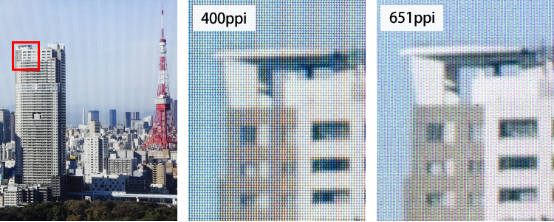This 3.42-inch display panel has a resolution of 1440×1700 pixels, an impressive pixel-density of 651ppi, and a refresh rate of 90Hz, reducing aliasing and dizziness. Japan Display (JDI) has just announced its latest LTPS FTF LCD technology, which is a display product developed specifically for virtual reality headsets. This new product aims to solve the pixel and refresh rate problems of some current virtual reality headsets. It is reported that this 3.42-inch display panel has a resolution of 1440×1700 pixels and an impressive pixel density of 651ppi. Such a high pixel density will eliminate the jagged problem of virtual reality device display content, compared with low-pixel products. There is a clear improvement. Currently, the pixel density of the best virtual reality headsets on the market is less than 500ppi. The pixel densities of the HTC Vive, Oculus Rift, and PlayStation VR are 447ppi, 461ppi, and 386ppi, respectively. Although the pixel density can reach 557ppi if you count the combination of Samsung Gear VR and QHD resolution smart phones, it is obviously quite different from the latest 651ppi pixel density of JDI. However, the highest record is currently maintained by Sharp, and the pixel density has reached 1008ppi. From the following picture, we can see the difference between different pixel densities in the display effect, which is what we commonly call the "screen door effect." In addition to a significant increase in resolution and pixel density, another important parameter is the high refresh rate. JDI's 3.46-inch virtual reality display refresh rate reaches 90Hz, which is also higher than the current mainstream virtual reality devices on the market. The high refresh rate is also a very important parameter that can help reduce motion blur problems and prevent users from dizzying and nausea. Careful friends must find that this new display of JDI is actually not a OLED material but a traditional LCD panel, and the main reason is the delay of the OLED screen. Google mentioned in the latest Daydream platform specification that the black and white delay of the screen must be less than 3 milliseconds, and if the OLED material is used, the delay will reach 6 milliseconds, which does not meet the requirements of the platform. Therefore, JDI decided to use an LCD screen with backlight technology to significantly reduce the motion delay blur. According to JDI, the future will continue to introduce 800ppi pixel density products, and provide a clearer viewing experience, but the premise is the need for the same performance GPU to bear this part of the pressure. At present, this 3.42-inch virtual reality display has begun distribution, and we can wait and see which VR device will be used first.
Computer
Mini Fan: This desk mini fan can be connected to a computer or a notebook to
make your work or study more comfortable.
Strong
wind and no noise: The computer usb fan uses a Hall DC motor to provide strong wind while quiet,
energy-saving and stable operation and will not influence you or others.
The arm
of the mini fan can be adjusted and the head can be rotated to about 105
degree.
With USB cable: USB
port rechargeable, powered by lithium polymer battery, our mini usb computer fan
comes with usb cable which can be charged with computer, power bank , mobile
power and other devices.
With the
gentle wind, just enjoy your happiness time. Different colors for choosing to
make your life more colorful.
Mini Cpu Fan,Small Computer Fan,Small Pc Fan,Mini Pc Fan SHENZHEN HONK ELECTRONIC CO., LTD , https://www.honktech.com
